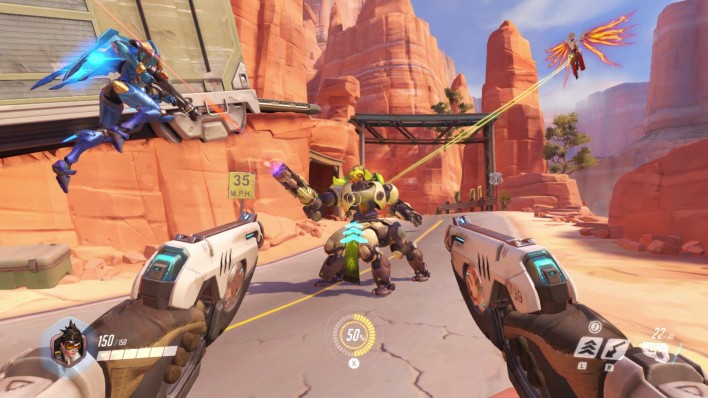
Photo by Robert Paul
A post suggested in the Blizzard forums brought the attention to Overwatch's lead designer, Jeff Kaplan. The original post stated to go 1/3/2 role queue instead of 2/2/2. The OP said that it would fix an ailing DPS queue time, create more exciting team fights, and a clear definition of what a tank is. Let's ask ourselves whether experimenting with role queue will fix the game, be an overall net positive for the overall health of Overwatch, a band-aid that sets the game temporarily, or if there are other solutions to help improve the game.
The issue with the current role queue — two tanks, two DPS, and two supports — is that we are stuck with a meta that involves an abundance of shields. Before role queue, GOATS was the meta that allowed for shields and health sustain to reign supreme. Changes are needed before role queue went live; however, those changes mainly affected heroes involved in GOATS. A positive was that it allowed DPS heroes back into the game. The problem was the DPS heroes that went into meta was not what everyone was expecting.
Before GOATS was a thing, those who wanted to play DPS heroes were forced to pilot Tracer and Genji, or snipers like Hanzo and Widowmaker. Now that role queue is here, the most effective team compositions aren't damage-dealing heroes; it is about sustain, it is about shielding your teammates.
Another glaring problem with role queue is queue times. For tanks and supports, you can expect an average wait time of fewer than five minutes. For DPS players, they have it tough with an average wait time of 10 minutes, sometimes 15 minutes.
Jeff Kaplan noticed the chronic issue with DPS queue times and took to the Blizzard forums to address it. In summary, he stated that the Overwatch team brainstormed ideas to reduce DPS queue times. One possible solution is changing the role queue composition to one tank, three DPS, and two supports. If this change took effect, an off-tank hero is affected. Additionally, the game, as we know, will shift from an ability-centric style to more of a tactical shooter with more DPS heroes playing each map.

Theoretical DPS picks you could see are Mei, Reaper, and Ashe. How about Hanzo, McCree, and Pharah? As you can see, the combinations are almost endless. More DPS heroes in each match would also present a faster match pace since shields, in particular, is not an issue as it is now. There are more role combinations to work with, but you need at least one tank and one support to keep those heroes relevant. Other than the many possibilities of modifying role queue, does it improve the quality of matches in Overwatch?
Role adjustment may improve match quality in the short term since the game will feel fresh, almost like a new, polished Overwatch. In the long run, though, the concern is if that fresh smell will sustain. The glaring problems in Overwatch are constant mirror matches. From a competitive point of view, teams are playing optimal compositions, which displays the best skills in professional play. From a spectator's point of view, watching similar matches in a row gets tiresome. Adjusting role queue can fix the ailing problems that are annoying Overwatch players. With three DPS heroes; instead, there is the possibility of planning various strategies to meet objectives — think of CS:GO.
For example, on attack in Temple of Anubis' point A, there is a Widowmaker perching on the building aiming at your backline. Your objective is to dance around the Widowmaker. You can use heroes like Pharah and Mercy to distract Widowmaker while the rest of your team pushes point A. Not only do you need to coordinate communication between teammates, everyone needs to be on the same page in terms of executing strategies in each match.

The fresh meta with 3 DPS heroes instead will take time to flesh out like when Overwatch first released. The problem, however, is that once players figure out a specific meta, we are back to square one — mirror matches.
One solution that could remedy the situation is hero bans. Other games like Dota 2 and League of Legends utilize a ban system to colossal success. It kept each match fresh, letting teams use strategies they devised for a particular match.
President of Gaming for the Boston Uprising, Chris "HuK" Loranger, stated ways that bans can be in the game. No doubt that implementing this feature is complex and needs extensive work, but it is possible.
One way to devise a ban system is by giving 3 bans per team. Then, the opposing team is not able to use those heroes for the entire match. However, your team is ready to use those heroes you banned if the opposing team does not ban them. It gives another depth of strategy that is not tested in the game yet. Even if hero bans are in the game, there is still a possibility of mirror matches depending on what heroes are banned.
The last solution is always for more patches into the game. Refreshing the game every two weeks or per month can put problematic metas into their place. We have seen it happen in professional League of Legends, for example. Patches come around every two weeks to fix anything that is abused in the game, tinker up or down champions that do not feel right in the current meta, or revert the game entirely. This kind of solution is easy to say, but we do not know the thought process inside the Overwatch team, so it could be more complicated than we think.
The thought of modifying role queue is a fresh idea that can spurt life into Overwatch. Players are tired of the current meta. What is missing from Overwatch is pop off plays, obscure strategies, and a balance to utilize most heroes instead of the same six. Things do not get fixed overnight. One step with tinkering Overwatch is better than nothing. Who knows — maybe fixing role queue is what we need to improve Overwatch. There is only one way to find out — give us 3/2/1.
Follow me on Twitter @itsjustchris for more coverage on Overwatch League and various games.
-

Writer @InvenGlobal | Freelanced at @overwatchscore @vpesports @GinxTV @Upcomer | Former CLICKON Media and Echo Fox.
Sort by:
Comments :0





